Parasitism is a close association between two organisms of same or different species. One of them which obtain nourishment from the body of other organism is called the parasite and the other organism is called the host. In this type of association, the parasite is the gainer and the host is the loser. Host may be adversely affected by the parasite but is not actually killed or destroyed.
The phenomenon of parasitism exists in various groups of the class Crustacea like Copepoda, Branchiura, Cirripedia, Isopoda and Amphipoda. The parasitic members are usually ectoparasites (The parasites that live on the host body surface), and these can be commercially important pests. Most crustaceans are dioecious organisms with marine or freshwater life cycles. Life cycles are varied, but generally the female produces eggs, which hatch into various larval forms. These undergo various numbers of molts, and transform into other larval forms or into adults. The larval stages also act as dispersal forms.
Morphologically, Crustaceans have segmented bodies covered with an exoskeleton. There are eyes, two pairs of antennae, mandibles, and two pairs of maxillae on the head. All these parts are often highly modified in some of the parasitic groups. The body shows varying degrees of fusion of head, thorax and abdomen. Appendages, when present, are usually biramous. Most female crustaceans brood their eggs in a pair of external egg sacs.
Effect on host: Sometimes the parasites may have no considerable effect on the host but sometimes the parasites may show dramatic effect on the host as a result of which the normal metabolism of the host is interrupted.
Feeding: The parasites greatly modify themselves to gain nutrition. In some forms feeding occurs by suction or absorption through general body surface.
Degeneration: The organs which are no longer used are degenerated in the parasitic forms. This phenomenon is called as parasitic degeneration. Because of this parasitic degeneration the parasitic Cirripedia and Copepoda look similar in shape.
Reproduction: To increase and ensure chances of fertilization, reproduction is massive.
Adhesive organs: These parasitic forms possess various adhesive organs like suckers and hooks which help in attachment to the host externally or inside the cavities. These suckers and hooks are specially developed organs.
Hermaphroditism: In some of the parasitic crustaceans hermaphroditism is induced type.
Sexual dimorphism: There exists a remarkable parallelism between the degree of parasitism and the degree of sexual dimorphism.
Life cycle: Generally to overcome various hazards in life, the life cycle of the parasites is very much complicated. But the life cycle in crustaceans is not complex as there is no need of wandering from host to host, no alternation of generation or alternation of hosts.
Most of the parasitic forms of class Crustacea belong to this subclass, Copepoda. The following are the general characters of the animals belonging to this group,
The following are the parasitic forms of subclass Copepoda,
Ergasilus: Ergasilus sps. is a member of a small group of parasitic crustaceans which are ectoparasites on freshwater and marine fishes. It may be found on the skin, fins, and gills of fishes. They can cause significant morbidity and mortality when heavily infesting fish.
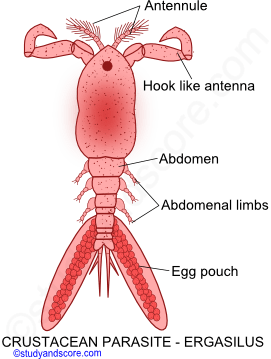
The offspring hatch and are broadcast into the water. The offspring undergo four molts before becoming adults. Ergasilus species are not host specific. Ergasilus infects eels, gars, herrings, killifishes, paddlefishes, perches, pirate perch, smelts, sticklebacks, sunfishes, temperate basses and troutperch.
Lernaea: Lernaea sps. are also known as anchor worms. They are parasitic among freshwater fish. The larvae are free-living, and resemble other free-living copepods. However, the 3rd copepodid stage is parasitic, and will seek freshwater fish. After mating, the males die, and the females undergo a remarkable metamorphosis to develop a prominent head which they use to burrow into the flesh of the fish. The penetration site frequently also becomes the site for secondary bacterial and fungal infections.
The posterior portion of the parasites protrudes from the skin of the fish. The adult female can survive up to 30 days, during which it produces pairs of egg sacs which can contain 200-250 eggs each.
Notodelphys: Notodelphys is the commensal parasite living in the branchial cavities of tunicates. They share the food of their hosts. They have true prehensile antennae and normal mouthparts. Their appendages are usually small. The exopodites of the thoracic limbs have a claw for attachment to the host. Females have a large egg pouch on the last somites. Both the sexes swim actively.
Caligus: Caligus lives on the skin and inside gill chambers of the fishes. It can swim rapidly. The body is clumsily built. It has piercing and sucking type of mouth parts. Proboscis is formed by both labium and labrum. Proboscis contains sickle-like mandibles for piercing.
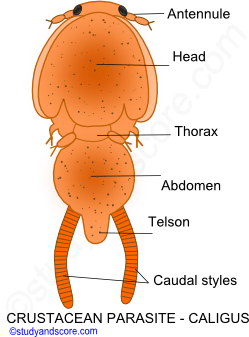
Monstrilla: Its first larval stage Nauplius is free swimming form but the subsequent larval stages are parasitic and sedentary in polychaete worms. The larval forms absorb nourishment from the host through antennae. But the adults do not have mouthparts and antennae. The adult after coming out of the host sheds off it antennae and assumes pelagic life as its digestive tract is vestigial. The adult lives on stored food. It has one dorso-ventral and median eye.
Anthosoma: Anthosoma lives as a parasite inside the mouth cavity of the fishes. The body of this parasite is greatly modified because of the curious overlapping of the lobes.
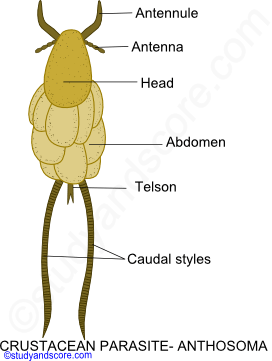
Chondracanthus: Chondracanthus lives on the gills of various marine fishes. It exhibits sexual dimorphism. Females are large, unsegmented with irregular lobes. They remain attached to the host permanently and they cannot swim as the appendages are degenerated. They do not have proboscis but the mouth has three pairs of sickle-shaped jaws. The males are smaller and are found permanently attached to the females near the genital aperture.
The following are the general characters of the animals belonging to this group,
Argulus spp. is an ectoparasite of freshwater fishes. Unlike the parasitic copepods, Argulus spp. also called as the fish louse is motile ectoparasites which can detach from one host and swim to another. Each individual possesses two adhesive disks with which it can adhere to the skin. There is a sharp stylus which it uses to pierce the skin and extract a blood meal. These species do not have egg sacs and the moulting process continues even in the adult forms. Fertilization is internal. The eggs are fastened in rows to stones and other objects. Development is direct with no nauplius or any other larval stages. Sexual maturity is attained after several molts.
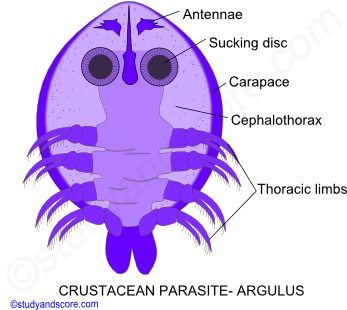
The following are the general characters of the animals belonging to this group,
Sacculina is the most important parasitic form of this subclass which parasitizes crabs. It is the most unusual barnacle. Although the larvae resemble free-living species, the female will attach onto crabs and develop in the gonads of the host crab, much like a tumor. The gonads of the host are destroyed in the process of the parasite developing, so that infection with Sacculina induces a phenomenon of parasitic castration.
Similar to other barnacles, Sacculina have a planktonic larval stage, the nauplius, and a settling stage, the cyprids. The adults are internal parasites (called the "interna"). They form cuticular tumors inside their crustacean hosts. These tumors can develop a system of branching roots that ramify throughout the host body and absorb their nutrients. The life cycle of Sacculina, therefore, comprises two stages: the endo- and ecto-parasitic stage.
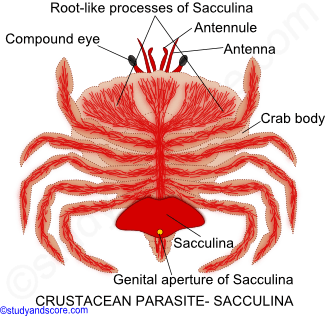
Sacculina larvae are dioecious. The male larvae are often smaller than those of the females. The life cycle begins with the female cyprid invading the crabs and then developing into a parasite with an internal root system (interna).
Once the interna matures, it will develop a reproductive body outside the crabs through the abdominal part called the virgin externa. Male cyprids will then enter the virgin externa, which give rise to a fertilized externa with the eggs brooding inside it. Larvae will then be released via the externa once the eggs became mature.
Other parasitic forms of this subclass are Syngoga, Laura, Trypetesa, Proteolepas.
The following are the general characters of the animals belonging to this group,
Aega: They are also known as fish louse. They have heavily built and piercing mouthparts. They have hooked legs and broad uropods which form a tail fan.
Gnathia: Certain sages of this parasite are called pranzia larvae which are intermittent ectoparasites of marine fishes. They have piercing and sucking type of mouth parts.
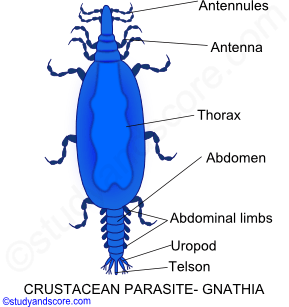
Cymothoa: Cymothoa have a short free-living planktonic phase. The juveniles and adults are exclusively parasitic living on the skin, buccal cavity and gill chamber of the fish. They have sucking type of mouth parts. They are hermaphrodite forms freely swimming and acting as males when young and become females after they settle down. The damage caused by them resembles that of other copepods but the most serious effect of isopod infection is destruction of host tissue resulting from the pressure of the parasites body
Bopyrus: Bopyrus lives as a parasite inside the gill chambers of prawns. It has suctorial and piercing type of mouthparts. It shows great degree of sexual dimorphism. Females are large with asymmetry and parasitic degeneration.
The following are the general characters of the animals belonging to this group,
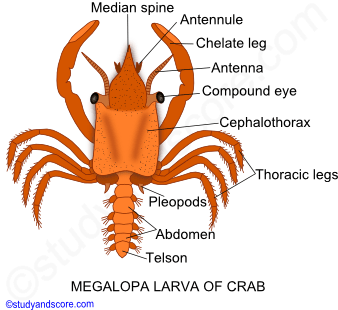
In amphipods, parasitism is not much seen but a few animals included in this group live as ectoparasites on the fishes. The most important of them is whale louse or cyamus which is an ectoparasite on whales. Its body is depressed and broad. Abdomen is much reduced. It has suctorial type of mouthparts. Its legs are clawed, to match its habit of clinging to the skin of the host.

- Share with your friends! -
Login to post your comment here...
- or with social Account -